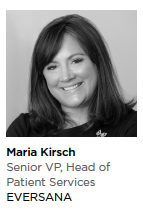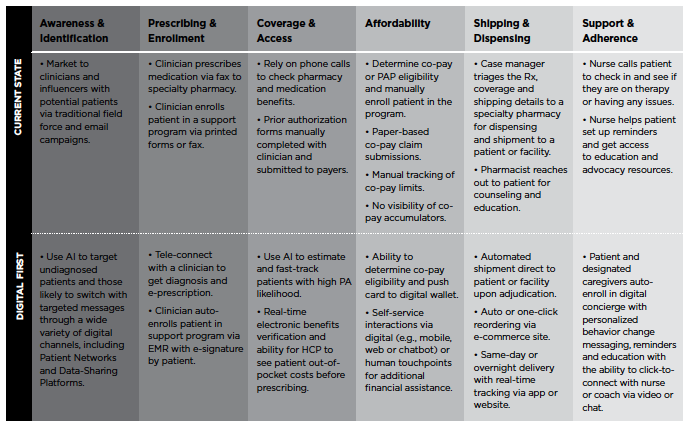 Since the onset of COVID, the world has seen a radical shift by consumers to digital channels out of both safety and convenience. This shift has occurred not just for everyday goods and services like online grocery delivery and digital banking, but also with big-ticket decisions — such as 30% of cars being purchased online (up from 2%), 30-plus states allowing consumers to close the purchase of a home digitally, and $500 billion of personal wealth now being managed by “robo" advisors. Despite this seemingly permanent shift to digital-first experiences, the experience around complex diseases and getting specialty medications to the patients who need them
Since the onset of COVID, the world has seen a radical shift by consumers to digital channels out of both safety and convenience. This shift has occurred not just for everyday goods and services like online grocery delivery and digital banking, but also with big-ticket decisions — such as 30% of cars being purchased online (up from 2%), 30-plus states allowing consumers to close the purchase of a home digitally, and $500 billion of personal wealth now being managed by “robo" advisors. Despite this seemingly permanent shift to digital-first experiences, the experience around complex diseases and getting specialty medications to the patients who need them  remains stuck in an analog world.
remains stuck in an analog world.
The Stakes Are High
Nearly 32% of Americans suffer from complex, chronic or rare conditions, such as autoimmune diseases, genetic disorders or cancer, many of which require a specialty prescription therapy. These medications usually require special handling and dispensing, such as by injection, inhalation, or infusion. Despite being only 3% of overall prescriptions, specialty medications represent nearly 50% of the overall prescription drug spend in the U.S. For certain rare diseases, the time to diagnose these conditions can be 6 to 10 years, and one in four patients have  affordability challenges in paying for prescription medications. In addition, 40% of patients experience at least a two-week wait time to get on their medication.
affordability challenges in paying for prescription medications. In addition, 40% of patients experience at least a two-week wait time to get on their medication.
While we moved to the on-demand economy in most sectors, many steps in the SpecialtyRx journey still require paper, faxes and phone calls. Once receiving a diagnosis and prescription for a complex therapy, many patients are often left to manage their own care, and both doctors and patients are frustrated by the lack of consistent and transparent communication at every stage of the complex care management process. According to a CoverMyMeds survey, a majority (82%) of patients reported spending an hour on the phone coordinating care for specialty therapies, with more than a third spending at least three hours — not exactly the experience you would expect in a modern, on-demand world, where convenience and experience wins.
Raising the Bar — The Digital-first Journey
If we could suspend our beliefs of what’s possible and the way things have always been, we could start from the needs and expectations of digital consumers and work toward what the SpecialtyRx journey should really be. Modern digital experiences should be immersive (any touchpoint), cognitive (use data to anticipate user needs) and trusted (responsibly leverage user data and be transparent on how this will create benefits for the user). What if we used this expectation to design the future SpecialtyRx experience? The illustration depicts how each stage of the SpecialtyRx journey could be transformed using a digital-first approach as well as some of the companies setting consumer expectations for these different interactions.
Road to Reimagination: What It Takes to Get There
Courage to challenge the current paradigm. Not accepting that “specialty pharma is different" or “this is the way it’s always been done" is the first step toward re-imagination. Ultimately, patients are consumers who want convenient, personalized experiences that anticipate their needs. They don’t want to be reminded they are sick and certainly don’t want to squander hours of their lives navigating archaic steps to get the medications they depend on. Companies willing to start with the lens of digital consumers are more likely to unlock the step-changes needed to transform the current SpecialtyRx experience.
Focus on user experience first and then on technology. For years, the industry has tried to transform healthcare through injecting new technology but has yielded only limited results because it failed to recognize the importance of the user experience. Digital solutions must integrate into the existing journeys or workflows of patients and providers to drive successful adoption. In the case of providers, digital interventions provided within the EHR workflow will see better adoption than those that require a separate interface or step.
Similarly, in the case of patients, rather than asking them to download an app, having a conversation through secure text messages can be a simple but effective means of engaging them and reducing wait times, especially when combined with a patient portal for additional content and resources.
Marrying the best of digital + human interactions. As models like Noom, Stitch Fix, and Sephora have shown, pairing the best of machines (AI) with the best of human advisors outperforms the best machines or humans on their own. This is no difference in optimizing the interaction model for patients with complex diseases, but there are situations in which humans will excel in understanding the unique needs, emotions and life situations of patients and others in which digital experiences allow them to more immediately access what they need on their own.
Enabling patients to co-create their own journeys. Too often, companies think interviewing a few representative patients is enough to validate their current patient experience instead of viewing these experiences as dynamic, continuously evolving opportunities for patients to  shape and influence their own interaction model. Sometimes just asking patients what they want to see in their own experience and adapting to this can provide a leap in personalization models versus trying to learn from scratch.
shape and influence their own interaction model. Sometimes just asking patients what they want to see in their own experience and adapting to this can provide a leap in personalization models versus trying to learn from scratch.
Starting with outcomes in mind. Every patient wants to get better, and clinicians want their patients to improve; but often companies lose focus of the end goal versus transaction metrics, such as patient enrollments or volume of prescriptions. Being able to engage patients and clinicians digitally along the SpecialtyRx journey enables companies to better learn and adapt to what will help propel each patient to a better quality of life given their condition and treatment plan. Whether it’s knowing when to encourage exercise and diet versus when to promote relaxation and meditation, each patient’s journey will be unique, and their definition of “good" will be their own. Helping patients define and better achieve their goals will be critical to keeping them on therapy and getting to the best health outcomes.
Creating new measures of success. Beyond improving adherence and better health outcomes (which are paramount), metrics — like speed to deliver, customer engagement/loyalty and overall customer delight — will matter a lot in the post-pandemic world. These are metrics typically found in consumer-oriented companies and will be adopted by progressive healthcare companies that are focused on delivering great experiences for their patients.
Despite all of the tragedy related to the pandemic, it has spurred a new wave of innovation and reset the bar on expectations for digital-first experiences in every industry, including healthcare. Specialty pharma is no different, and companies that seize the opportunity to re-imagine the SpecialtyRx experience in a digital-first world will win mindshare and loyalty with the next wave of patients and clinicians. Most importantly: the value of getting more patients, many who live with debilitating conditions, the treatments they need at the speed of digital? Priceless.(PV)
EVERSANA is the leading provider of global commercial services to the life-sciences industry. Our integrated solutions are rooted in the patient experience and span all stages of the product life cycle to deliver long-term, sustainable value for patients, prescribers, channel partners, and payers. We serve more than 500 organizations, including innovative start-ups and established pharmaceutical companies to advance life science solutions for a healthier world.
For more information, visit eversana.com.


















